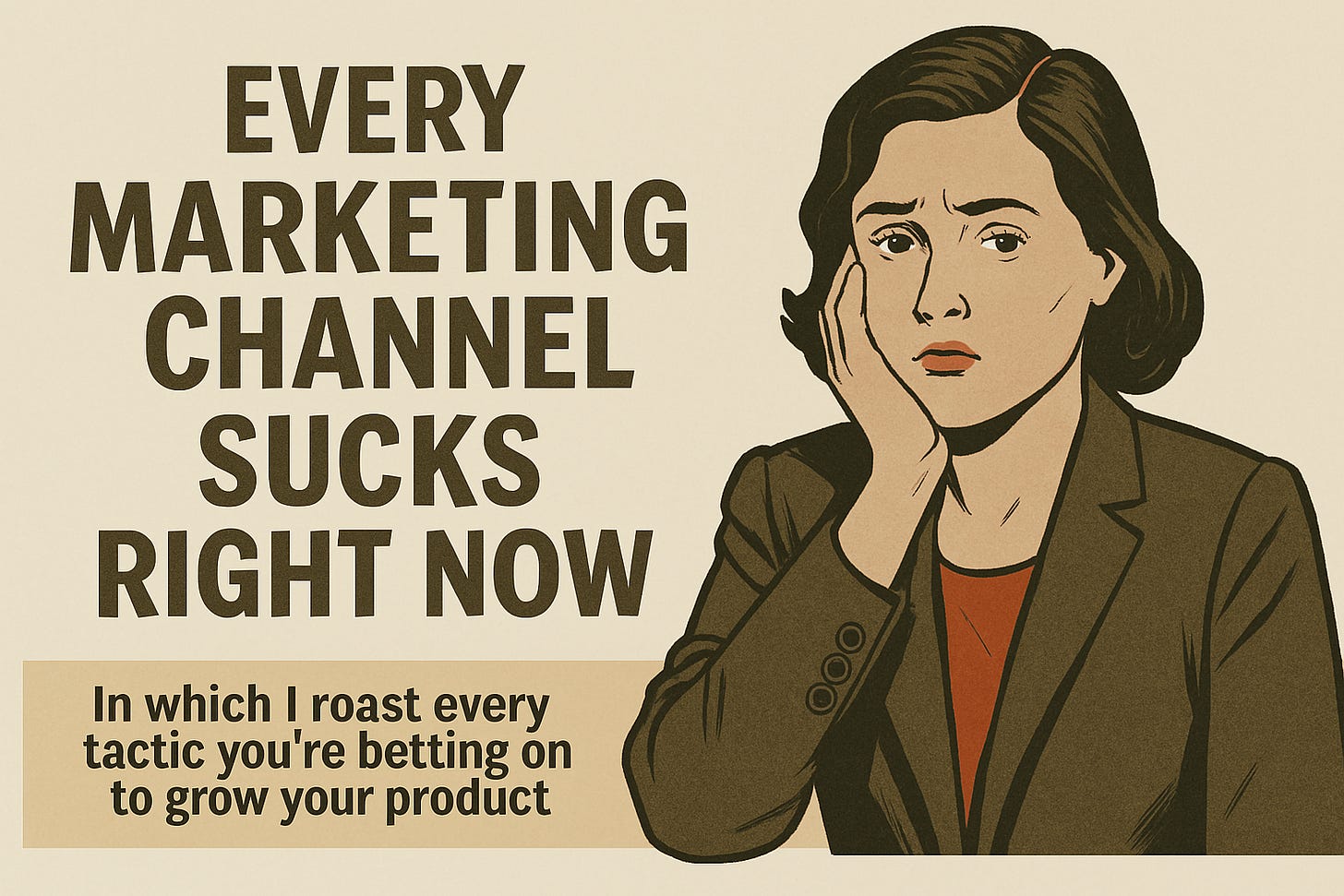Yes, I’m about to roast every tactic you’re betting on
These days I’m spending a lot of my time with very early stage startups (yes, as part of the program at a16z to invest up to $1M into each, called a16z speedrun) and as part of this, I spend a lot of time talking about launch and marketing strategy for new products.
The options for marketing pretty grim right now. Here are my complaints:
-
SEO: Takes too long, you’re competing against listicles (and Reddit threads), Google might screw you over at any moment, maybe AI one boxing will kill your traffic next year anyway 🙁
-
Influencer marketing: Get a big spike of traffic but none of it converts, the spike goes away after a few days, big creators are too expensive and a slew of small creators need to be cobbled together, lots of babysitting 🙁
-
PR/comms: Doesn’t actually generate signups, doesn’t scale and not repeatable, expensive retainers for PR experts to grab coffee with journalists, your competitors will get the same article next month, and press is as likely to attack you as to cover you 🙁
-
Email marketing: hope you like spam folders, building a good list takes forever, open rate rates are <30% and CTRs are>
-
Viral loops: doh you need an actually great product, all the contacts spamming techniques no longer work (neither email nor SMS!), your UX will be ruined by aggressive popups and onboarding schemes, and it’s nearly impossible to get viral factor >1
-
Ads: way too expensive, always getting more expensive, your competitors will just copy your copy, lots of fake/low-conversion clicks, your investors hate it, and it’ll kill you if you don’t have a strong business model already
-
Referral/affiliate/etc: be ready for a crazy amount of fraud, it’s just as expensive as paid marketing (though people fool themselves into thinking it’s not paid), and surprisingly most people don’t care and will get fatigued quickly! 🙁
-
Big launch on social: it can only happen once, you’ll have to spam all your friends to share and over time they might come to resent you, the algo is always working against you, and it only lasts for a few hours 🙁
I could keep going… but you get the picture!
Unfortunately this is the state of growth marketing. A lot of channels are not working, or are slow, expensive, or one-time only. This is the natural end state for things, and maybe we’re in a bit of a lull due to the technology super cycle as we’re 15+ years into the mobile wave, we’ve had various kinds of paid ads for 20+ years, and so on. All of these aforementioned marketing channels are now fully mature.
The Law of Shitty Clickthroughs, Redux
This is the logical ecosystem-wide conclusion for the concept I wrote about many years back, The Law of Shitty Clickthoughs which inspired by the efficient market hypothesis. It said the following:
Over time, all marketing strategies result in shitty clickthrough rates.
I encourage you to read the full essay if you haven’t, but the tldr; is that when marketing channels work, everyone jumps in on them, and they start to decay like crazy.
Why do they decay? Because customers stop responding over time — they start ignoring things as the novelty wears off. The ROI also goes down, as all the intermediaries that charge you for access to their audiences jack up prices. The super slick self-serve, automated auction model for paid marketing offers many pros and cons, first that it lets you aggregate much larger audiences with simple tools, but by making it easier, of course you end up with a ton of competition that then drives up CAC. In other words, as a marketing channel scales and ages over time — and yes, we’ve had SEO as a concept for 25+ years now — consumer engagement goes down, costs go up, competition goes up, ROI drops like crazy.
Big channels versus Little channels
All the aforementioned marketing channels are what I describe as “Big Channels.” They have scale, can be moved using $ (or labor, which costs $). And if you’re a big successful company, you might be fine because you have a (hopefully) strong brand, you get a bunch of organic traffic from word of mouth, you (hopefully) have a successful product that can cross-sell into new products, etc. You can have badly performing Big Channels because it’s all blended into a longer LTV recovery period, more organic, and all the other advantages that successful companies have.
But let’s talk startups, who have none of these positive dynamics? I want to lay out a few thoughts:
-
Don’t focus on Big Channels, focus on Little Channels. first, you should just know that all the aforementioned big, mature channels will suck for you. These channels have mostly all been bid up by bigger companies, and they are mostly stale to consumers, and you don’t have the same LTV and financial strength as an established product. Instead, a new startup has to be asymmetrical — what you can do that they can’t? The natural solution points towards Little Channels, which are all the smaller marketing strategies that are tried in the early days and abandoned over time.
-
Don’t worry about scaling. Let’s say you have a new product with only 100 active users. If your marketing campaign gets you +500 actives, you’re ecstatic. Gain a few hundred users inside an established company, and you should clean up your resume. Thus, little channels can work: Running mini events with cool speakers, organizing a Facebook group, going after a single college/company/town, emailing your ex-colleagues/friends to try a new thing — these can all help in the early days. You won’t have the competition, the response rates will be higher since you’re doing it all by hand, and you can always scale over time by moving onto the next channel.
-
Novelty is in your favor. There are only so many ways to sell a big established product to customers. The “wow” moments have all been used, the value prop is already understood. The response rate on marketing declines as a result. But if you’re a new, bright-eyed and bushy-tailed product on the market, and you have a “wow” product that presents well in a hype video, then you can get a nice big spike when you launch. And maybe even a few more smaller ones over time.
-
One-time is fine, repeatability is what you do later. A lot of marketing tactics that work in the early days only work once — like a social media launch — but that’s OK. If you can prove that a few unscalable tactics work, and it helps you gain momentum via funding/hiring/otherwise, then over time you’ll have more time to try additional strategies.
-
Your product is brand new, so your marketing can be brand new as well. When you build a new product, it’s always smart to take advantage of the new tech wave, so that you can create something different than what’s existed before. You want to be building a mobile app in 2010, not a website, and you want to be building in AI now. But in the same way, you can use these new technologies on the marketing side too. What does AI allow you to do in marketing that previously couldn’t happen? Whether it’s rapidly creating personalized creative, or generating concepts faster, or creating an interactive bot — what can you do different than no one is doing, using the new tech?
-
Take risks with your brand. You can attract people with your brand by being polarizing. Say “this product is not for you, it’s for these other cooler people.” Or hit competitors directly in the face, in your marketing. Be aggressive. These are things that long-term employees of the world’s trustworthy brands can’t do, because they are being protective, and managing the downside. You need to do everything you can to stand out, because being ignored is the worst outcome for any marketing tactic.
The point is — yes, today’s marketing channels sucks, but that has everything to do with the level of competition and the rate of customer fatigue. So go innovate! Try reaching people in new ways, say novel things to people they haven’t yet heard, and if you have to trade off anything, just trade off scalability. (You can deal with that later once your product is successful even at a small scale)
Product is (unfortunately) King
So I have bad news: Your product actually has to be very good. I wish I lived in a world where you could have amazing marketing and growth strategies, have a shitty product, and you would win. Then marketers would run tech, and they do not. It’s the people visionaries that create the products that run tech, and that’s a good thing!
The reason is that even if you do a ton of work to acquire a bunch of users, it won’t matter if they leak out of the DAU number. I’ve come to think of great marketing strategy as a multiplier effect on your inherent product quality. If you have a great product, you will multiply that into greatness. If you have a shitty product, you will multiply that into… well, you get it.
I think we’re seeing this in the AI wave at the moment. You have great, highly novel products and when one startup makes a hype video, it just goes viral. They don’t know anything about funnels, A/B testing, CAC, etc. The product is just killer, and the output is highly marketable, and as a result social media really works well for them.
A year from now, I think the novelty value will have faded a bit — we aren’t as impressed by the output of image generation models compared to when they first came out. If the novelty fades, as I predict, then in a few years we’ll need to really figure out how to market these products. (Sorry AI researchers, you’re going to have to learn marketing and sales!)
Every marketing channel sucks, but it’s going to be OK
This essay was not meant to be depressing, but rather to just call out the idea what we can all see — that most of the channels we work with are decades old, that the performance is teetering on an edge. Just as products are innovating by adopting new tech — AI, XR, web3, and so on — we in the marketing field need to innovate as well, by asking ourselves, where can I do something new with XYZ new tech?
And it’s very clear that we should not copy incumbent products. They have too many features — try something smaller and more targeted. But the same is true in marketing. Don’t copy the established products and try to execute in Big Channels — instead, think asymmetrically. What can you do that they can’t, and going with small channels is always a great place to start.








